
TL;DR - If you just want an understanding of emerging search trends and how to capitalize on them, jump to the "Changes in Search Demand" section. Otherwise, we’re going to build an economic context to help you understand those trends and how to use your marketing to help people through the pandemic.
What a time to be alive!
We are in the throes of a global pandemic and everything is effectively up in the air. Governments are scrambling to make sense of it while attempting to stave off a contraction of the global economy. People are losing their jobs and struggling across various points of the isolation spectrum. Meanwhile, consumer behavior is mutating and there’s no telling if we will ever return to what we think of as “normal.”
Simultaneously, marketers are trying to convince companies to keep spending marketing dollars and power through. Or, they are trying to figure out how to somehow hold on until a recovery, but there is no telling where that recovery is on the horizon.
As a consumer, marketer and small business owner, I’ve sat back synthesizing a lot of information and wanting to make sense of where I believe we are heading. That’s not to say that I’m above sharing a study from a management consultancy to convince you should continue to invest in marketing, but I prefer to paint the bigger picture.
What I can say, definitively, is that Search is continuing to show its strength as one of the most powerful market research panels in the world. Google’s Search box has the unmatched ability to encourage people of all walks of life to codify the latest iteration of Maslow's Hierarchy of Needs in Orwellian DoubleSpeak.
I reached out to the Advanced Web Ranking team to see what types of aggregated data we could review across their customer base so we could get a sense of how Search demand is shifting. Philip and his team were kind enough to spin it up for me.
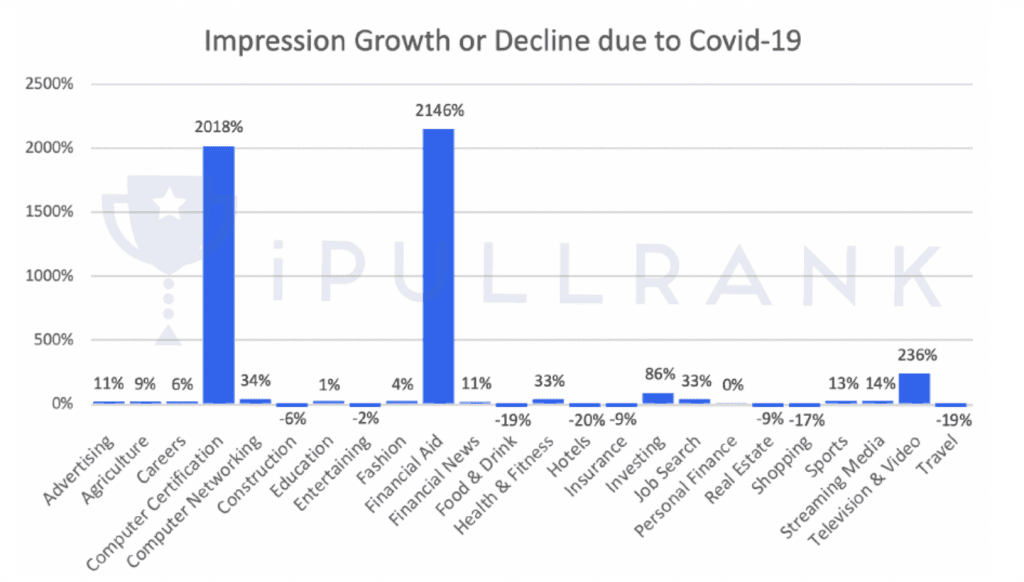
Voila! We quickly get the ability to passively take the temperature of the community and verify where their interests and needs are shifting during this crisis. As you can see in the above data anonymously derived from Google Search Console impressions in Advanced Web Ranking’s dataset, key areas such as Construction, Hotels, Insurance, Entertaining, Real Estate, Shopping, and Travel are all seeing declines. This comes as no surprise, however, because these are all things that cannot effectively coexist with Social Distancing mandates. For example, how much do you need insurance if you can’t leave the house?
On the positive side, the dataset is showing dramatic increases in demand for Financial Aid, Computer Certification, and Television & Video. Many people are finding themselves jobless and looking for something they can do online and remotely between binging on the latest season of Ozark.
As marketers, we are all engaged in an on-going and interactive study of consumer psychology. I want to explore the new context we’ve found ourselves in and determine how we can use that context to support both consumers and producers.
Environmental Factors
Naturally, there are a series of environmental factors at play here. It’s not just that people are getting sick and reacting to a virus; global interdependence is also meaningfully impacted by people’s inability to work during the pandemic. With the coronavirus starting in China, and all of the planet’s supply chain routing through the Celestial Empire, we are also witnessing a supply chain reaction.
While the effects are, of course, international, my personal context is the United States -- New York City to be exact. Like much of the world, we are heavily dependent on Chinese imports. From Wine & Liquor on the low end to Computers and communication equipment on the high, according to the US Census Bureau, the US of A imported over $446 billion in goods from China in 2019. Many of these goods are not final products, rather the materials and machinery required to create goods that are made available around the world.
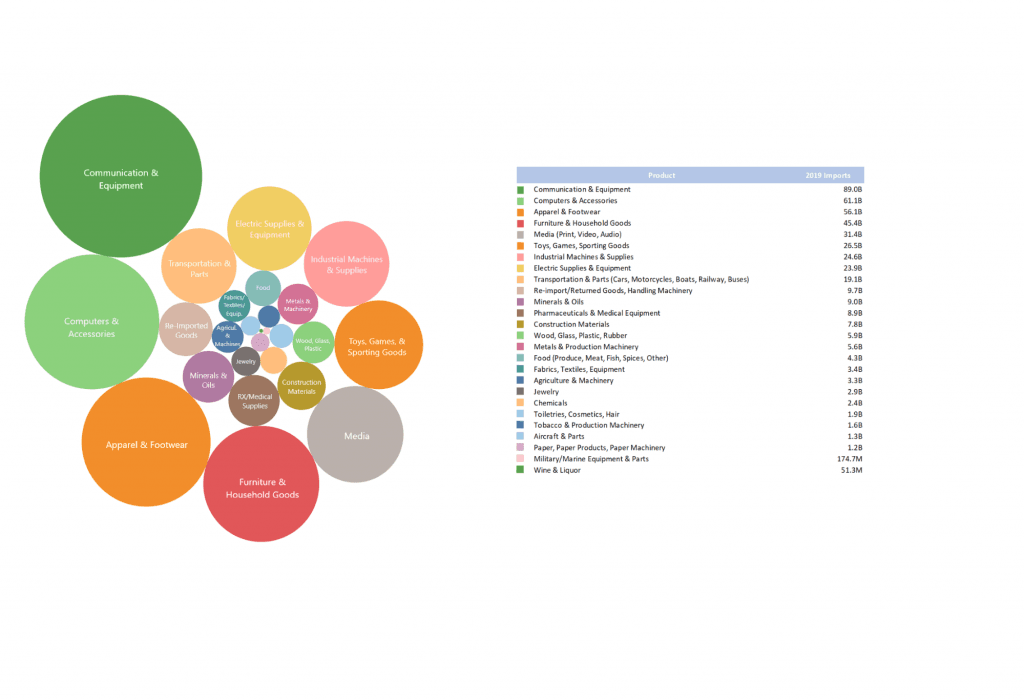
With COVID-19 quickly reaching a literal fever pitch, China went on lockdown at the end of January 2020. So, before COVID-19 became China’s major export, the world was already poised to experience delays in the availability of goods and services of all kinds.
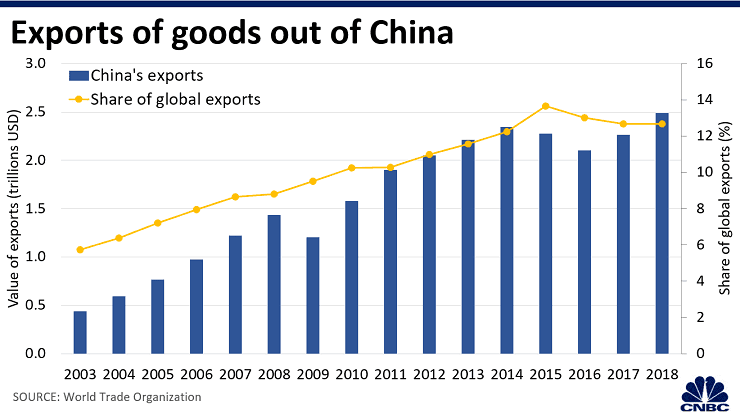
This is a global issue because China is also the world’s largest exporter, so the impacts on goods and services would have a global impact even if the outbreak was limited to China. With the majority of the world in quarantine, it is difficult to fulfill many physical goods, especially at the speed that we’d grown accustomed to.
According to a Digital Commerce 360 study, most retailers are expecting shortages and delays. Consumer behavior is changing in reaction to scarcity, both in stores and of stores.
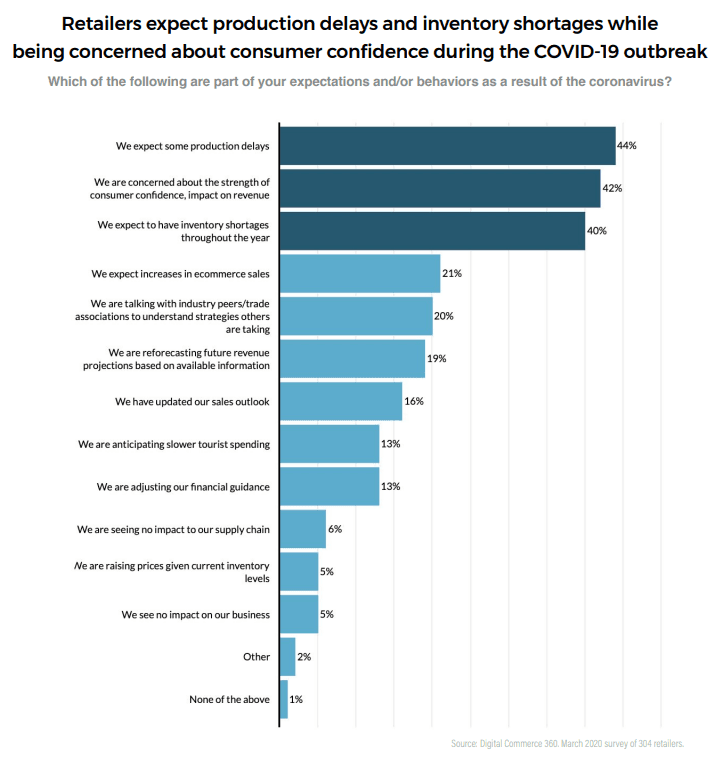
As an NYC resident, I wanted to purchase a printer to work on this article (don’t ask) and Amazon said it would take five days to arrive. I’m used to receiving things the next day. My other options were stores that I couldn’t be sure were open. As a consumer, I am confused and unsure if I can trust retailers at this time.
Shifts in Supply and Demand
Supply and Demand is, of course, the core market driver outside of consumer confidence. However, it’s generally a more subtle force that rears its head over time. In the case of COVID-19, we’re instead seeing drastic and dramatic swings in real-time.
Consider the airline industry. According to the IATA, passenger demand was projected to grow by 4.1% in 2020.
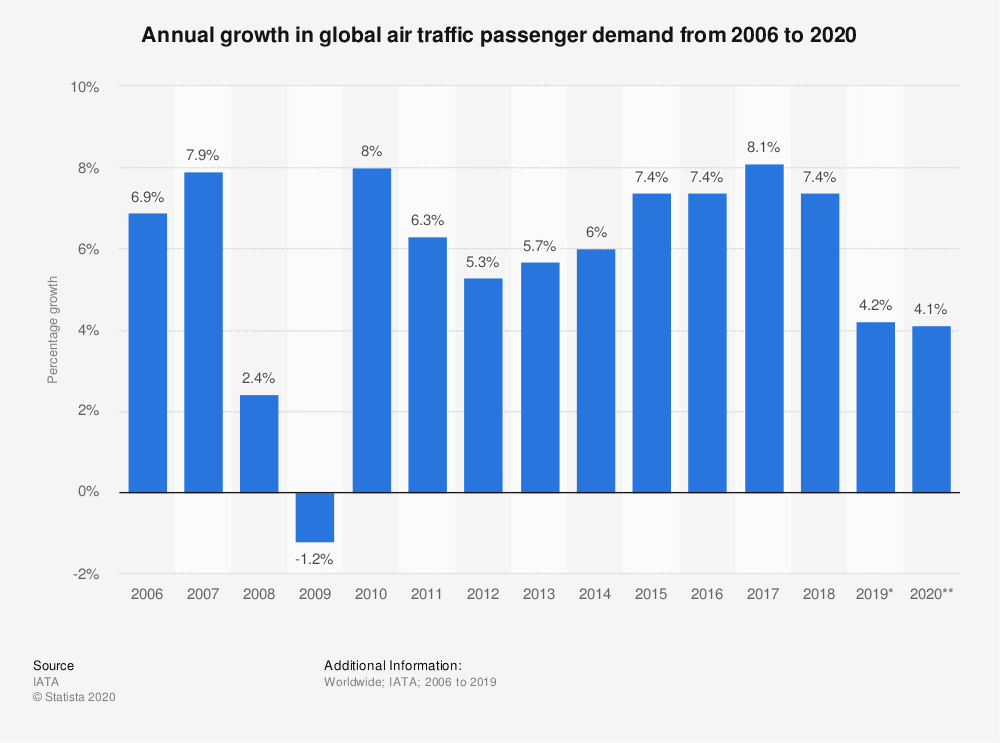
Instead, with multi-national companies curtailing business travel for their employees since early March, and the shelter in place mandates coming on line late March, demand made a crash landing. First flight prices were sent into a tailspin, shortly thereafter supply took a nosedive in accommodation as airlines could no longer justify keeping so many empty planes in the air. IATA’s monthly statistics data illustrates just how far that demand has fallen.
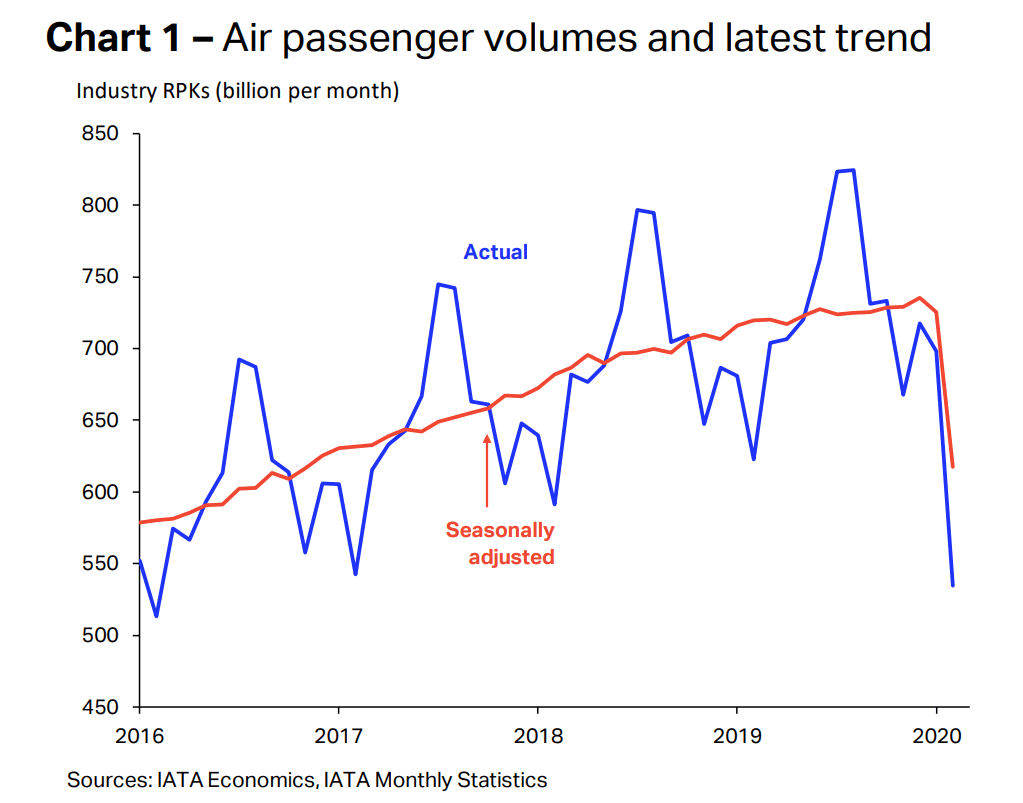
Unfortunately, the airlines continued to be grounded by bad news and have struggled to identify a new supply and demand equilibrium. As a result, many large airlines have had to furlough or otherwise layoff thousands of employees. Typically, this type of dramatic change in demand takes multiple quarters to identify. Companies have changed management solutions to react slowly in measured ways to recover. In the face of a pandemic, it’s proven to be impossible.
In other instances, N95 Masks, hand sanitizer, and toilet paper demand has skyrocketed. As China’s supply chains have slowly come back online, D2C companies have sprouted up with Shopify stores in their wake. You can find them in ads on your Facebook timeline with slightly different creative and random company names as seen below.

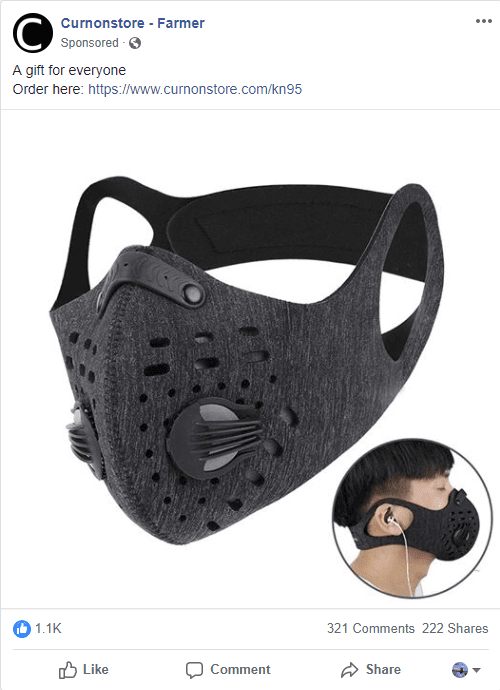
Thes companies tend to be small, agile and utterly expendable. They find a supplier that can dropship and they throw up a site, some compelling ad creative and capitalize on Facebook’s low CPAs. This is an example of high demand meeting low supply.
What we’re experiencing is unprecedented in the Information Age. There are a lot of comparisons to the 2008 financial crisis, but this isn’t that. Nearly all businesses are closed. Supply chains are disrupted. People are effectively on a suggested house arrest and there is no definitive end suggested prior to a vaccine that may appear in 2021.
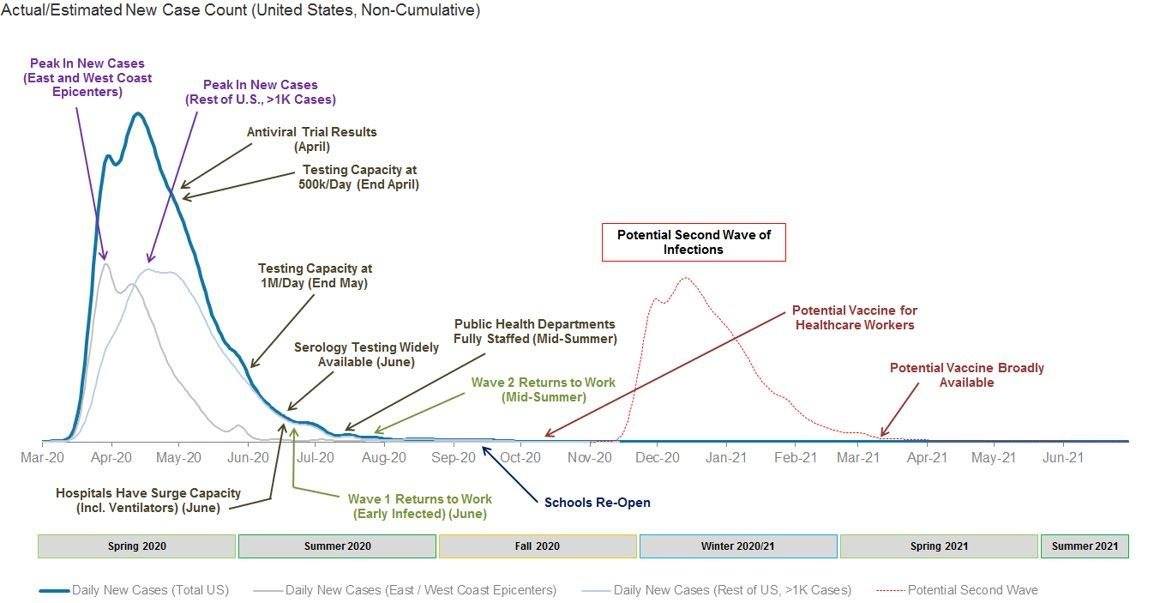
Based on Morgan Stanley’s model, it’s unrealistic to expect the economy will achieve a new equilibrium until 1-3 years from now.
Producer/Company Behavior
If you do Marketing of any kind right now, you are feeling the direct effects of companies pulling budgets. In times of uncertainty, any type of company needs to enforce financial discipline and be more conservative in its spending. CFOs are dialing into Zoom calls everyday to do their fiduciary duty of trimming the fat and tightening the purse strings.
How is that playing out so far?
Well, according to a survey run by IAB, 98% of agency respondents have indicated that ad spending has been cut for Q2 2020 as a result of COVID-19. Q3 and Q4 are still on the chopping block but have been less impacted thus far. This suggests that many companies are in a “wait and see” pattern.
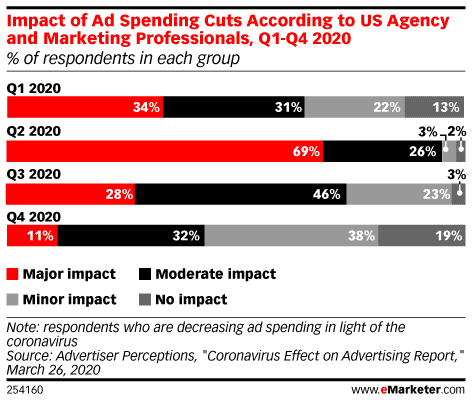
Companies are seeing less value in branding channels like Display and Paid Social. However, interestingly enough, agencies are indicating that Paid Search campaigns are net zero. This makes sense that brands may want to pull back spend here and focus on more direct acquisition opportunities.
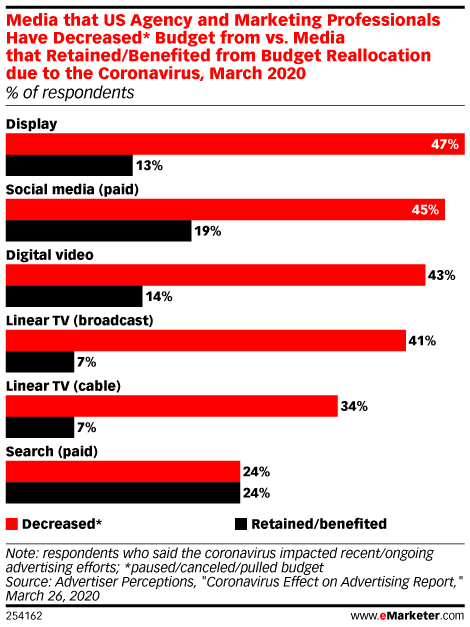
What’s most interesting is that the LinearTV campaigns are taking a hit as well which suggests that COVID-19 may be inducing a shift from traditional media to digital and Search is benefiting most because brands have a direct ability to be reactive to intent.
That said, everpresent yet anonymous analysts are projecting that Search spending (both Paid and Organic) will be down between 8.7 and 14.8% after several years of growth.
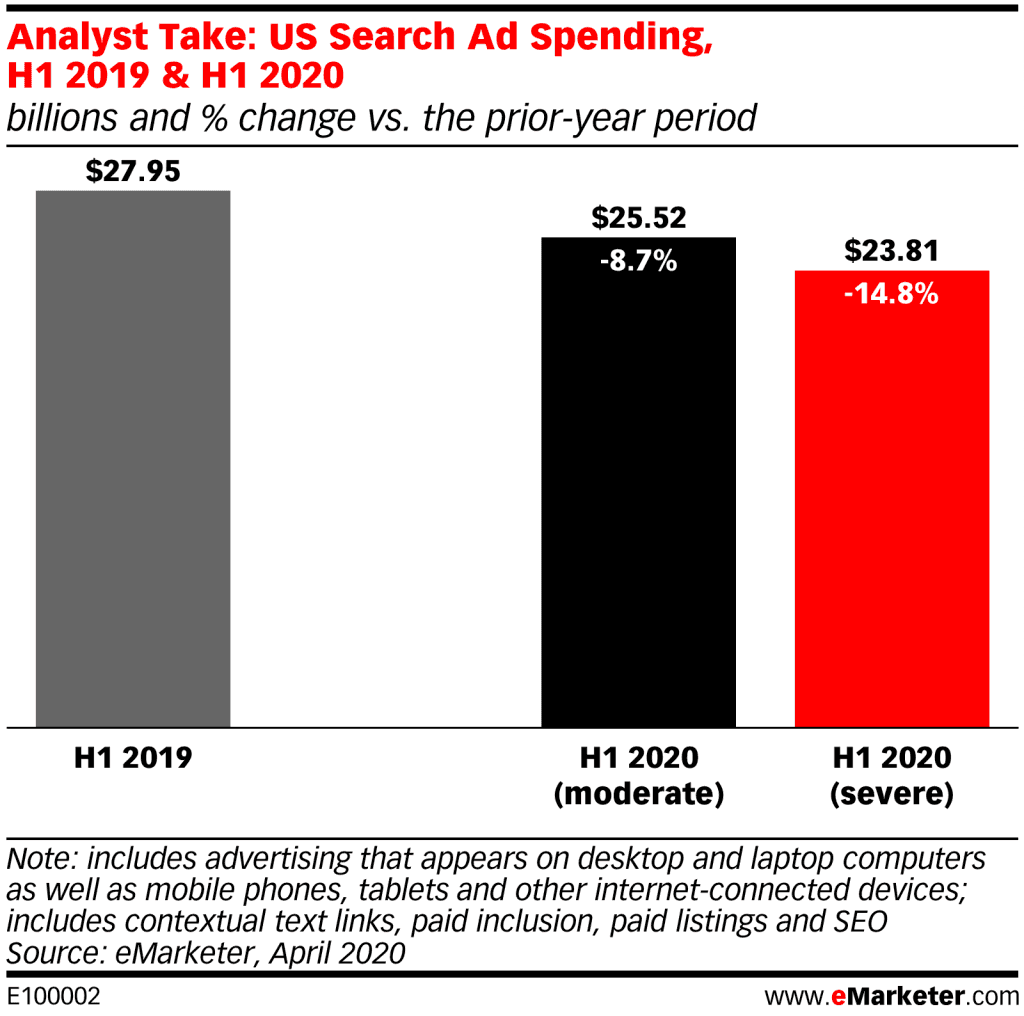
Let’s dig in a bit further to determine why Search has unique opportunities and spending less on it may be a mistake.
Economic Downturns Favor the Bold
I warned you that I might go full Marty Kaan at some point.
Markets are inherently irrational, and an economic downturn is always an opportunity. A market collapse due to a global shut down is rational, but these are the moments when fortunes are made and it is the companies that continue to strategically invest that make out stronger on the other side. Those companies that become overly conservative during market uncertainty are the ones that lose brand awareness, market share and ultimately fall behind competitors that fill in the share of voice that other companies vacated.
A Bain & Co. study indicated that those that remained in a measured growth mode through the 2008 recession, saw a 14% profit advantage after the economy recovered over those that turned more conservative.
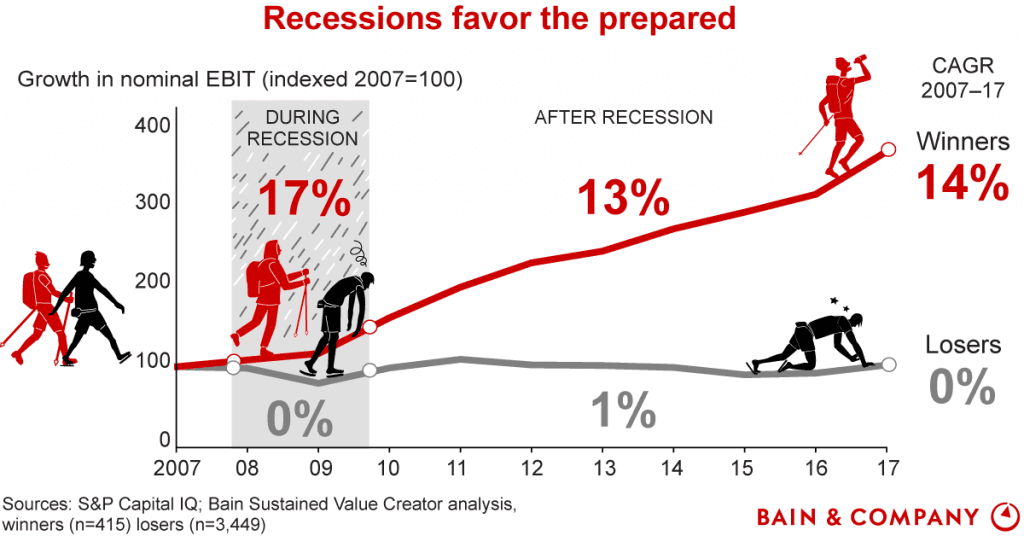
That study, found in Bain’s Beyond the Downturn: Recession Strategies to Take the Lead article presented it in an especially compelling way:
"Companies that ranked among the eventual winners, by contrast, moved deliberately to capture opportunities before the recession. While they focused intensively on cost transformation, they also looked beyond cost. Think of a recession as a sharp curve on an auto racetrack—the best place to pass competitors, but requiring more skill than straightaways. The best drivers apply the brakes just ahead of the curve (they take out excess costs), turn hard toward the apex of the curve (identify the short list of projects that will form the next business model), and accelerate hard out of the curve (spend and hire before markets have rebounded)."
Brands are pulling over on the autobahn to be passed at high speed by those that stay pushing in web traffic. In other words, you should put Search on that shortlist.
From a digital marketing perspective, the opportunity is clear. CPMs for Facebook and Instagram are down and while I cannot find aggregated data on CPCs for Google Ads, discussions with Paid Media specialists indicate the same is true of the channel previously known as Adwords.
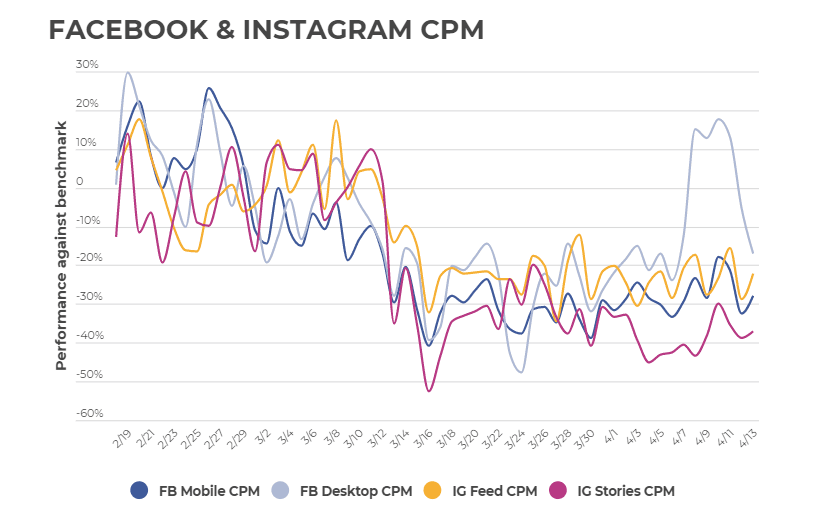
It makes sense, after all, these advertising platforms function as auctions. If there is less competition in the auction, winning is cheaper. If winning is cheaper, you have more opportunity to be seen and more opportunities to convert users into buyers.
Every marketing dollar will go further than it did last month. If you’re considering cutting your budgets, perhaps Search isn’t the right place.
Consumer Behavior
The more important part of this discussion is - what are people doing?
Personally, I wince whenever I hear the term “new normal.” In most cases, it’s presented as though it’s a temporary state. Hidden within those three syllables is the expectation that, two months from now, we will tune into the news and everyone will walk out of their home simultaneously, celebrate, and resume everything they were doing prior to the quarantine.
In reality, this pandemic is unprecedented within the lifetimes of most people that are experiencing it. As a result, consumers are forming new habits as you read this.
Suffice to say, if market segmentation is a core component of your strategy (it should be) what you believe to be true of those segments is no longer accurate.
Consumers Are Distracted
Perhaps the most important aspect beyond consumers being scared to spend money is that they aren’t paying attention.
In the US, people are glued to the news media and preoccupied with fear and uncertainty. They are not paying attention to the things that they normally would. At our core, they are living with the cognitive overhead of being concerned with their health and their ability to maintain their lifestyles more so than in the entire history of the public Internet.
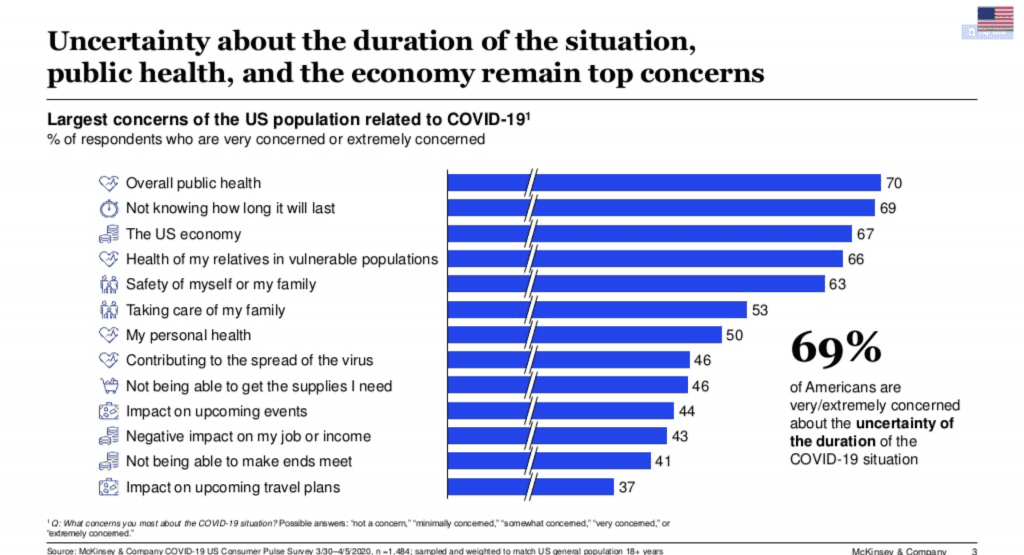
This is reflected in Search in the United States; people are waking up every day and looking up what’s happening with the coronavirus. The spikes in interest in this Google Trends chart happen between 7 and 9 am on a daily basis.
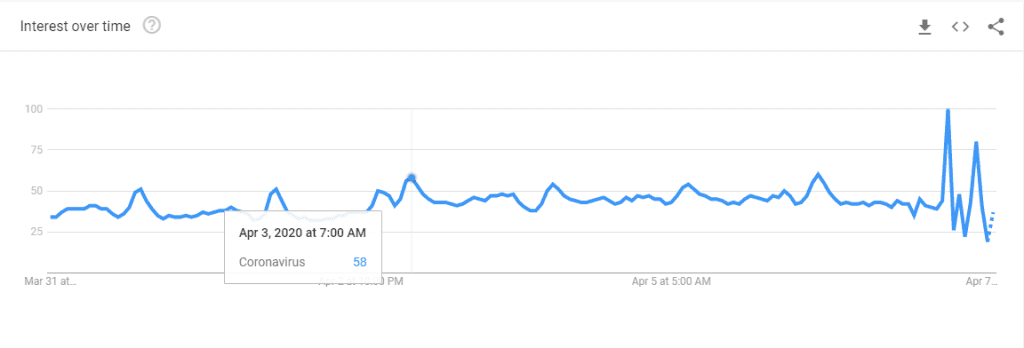
Conversely, Worldwide, people are checking on it before they go to bed
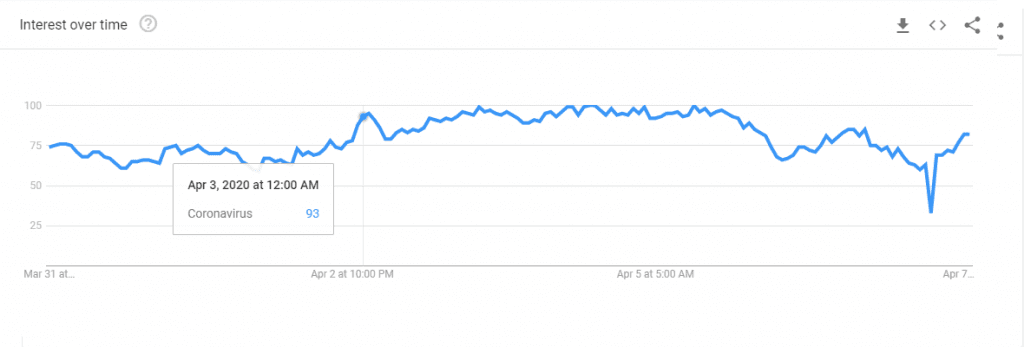
The ultimate question you have to ask as a brand is - how can we help people through this pandemic or how can we help them escape?
Consumer Behavior is Different…and It May Be Permanent
Right now people are two things the regular pace of the world usually does not allow them to be en masse: bored and afraid.COVID-19 is an existential crisis the only thing to do is sit and wait.
With fear of leaving the home, there has been a shift in online shopping for essentials like groceries and cleaning products as well as an increase in the need for reading materials and entertainment.
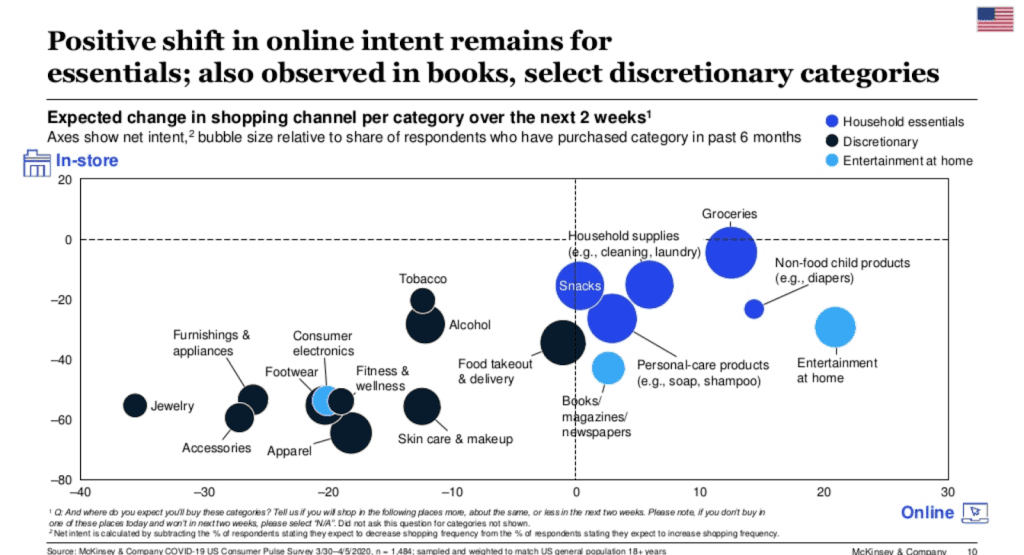
Before the US government began treating COVID-19 like the pandemic that it truly is, entertainment companies delayed the debut of films like the latest James Bond. Now, with Trolls: World Tour we have the first example of a media company leaning into streaming first in lieu of a theatrical release. Consumers reacted. Reader -- your author reacted. Anything that keeps my three-year-old daughter happy while she can’t go outside works for me.
With the record-breaking release, the US was just effectively trainer to pay $20 for a film you can only watch for 48 hours. Hollywood knows this works and you can rest assured that they will attempt to build a new consumer habit out of it to combat the losses they are experiencing.
And you know what? Going to the grocery store is a chore. How many will go back to it once the world re-opens?
All in all, spending is down, so the net effect is not positive. Consumers are shifting their dollars to e-commerce. So, it’s counterintuitive that brands would want to pull their spending from there because that’s where a large part of the opportunity to pull a brand through the downturn lies.
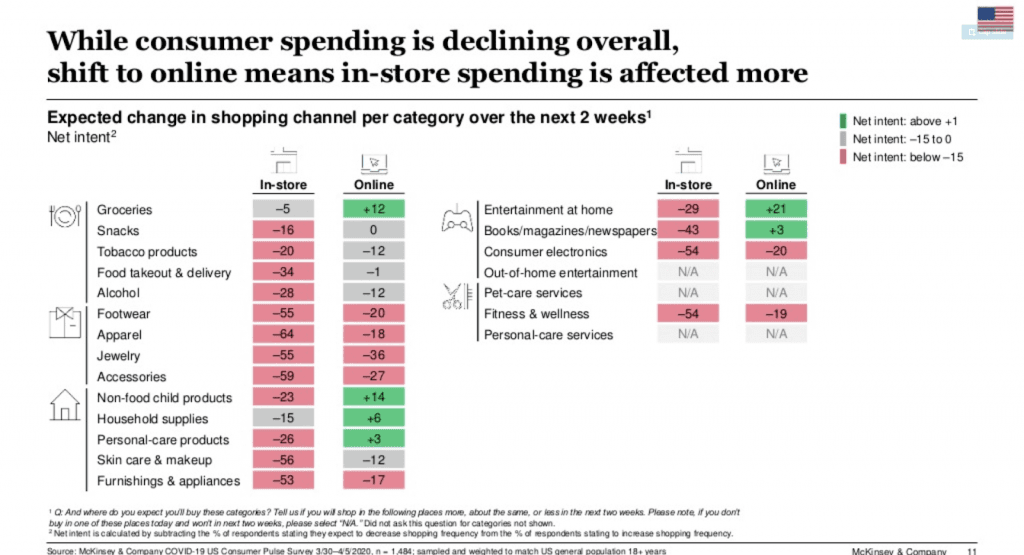
The composite dynamic at play is that demand is up in specific areas, supply is down, but the competitive landscape is receding and the channels that brands are choosing to be active in are shrinking. This is perhaps the best time to double down on Search because it is the most efficient channel and you get a short feedback loop that includes results against consumer intent.
Changes in Search Demand
I took the long way to get here, but as with any data, context is important. Let’s examine Travel, Fashion, Food and Drink and Personal Finance to see what has changed and how marketers can leverage Search to both help people and drive growth during the pandemic.
Travel

Travel acts as the bigger picture industry, but the data that Advanced Web Ranking provides also allows me to dig into Air Travel more specifically.
Air Travel

Industry Change - Travel, in general, has seen a gradual decline as the news of the Coronavirus headed east from Wuhan to Seattle and then onto NYC and Europe. There have been increases in search demand for Air Travel largely due to people’s need to escape back home and to find more information on how to cancel their flights.
Emerging Search Terms - diamond princess locator, spain, [airline name] cancellations, [airline name] customer service, domestic flights USA
Shrinking Search Terms - train times, booking, destinations, [airline name], [destination name]
Content People Need - There is a demand for transparent and aggregated content about how travel has been impacted by COVID-19. People are looking for guides on how to navigate their cancellation, flight tracking visualizations, videos and interactive experiences that clarify how flight safety has changed. People would also benefit from information on when their destinations will likely open back up, what deals airlines are offering for those time frames and how to approach emergency travel should you absolutely need to go somewhere. Travel aggregators and bloggers are better suited to prepare this content as they show comparisons between airlines and offer objective opinions.
How Brands Can Help People - Brands can help people by putting them first by proactively notifying people of how to cancel flights and accommodations and not burying that content deep in their sites.
SERP Opportunities - COVID-19 Announcements Schema, FAQs Schema, and Q&A Schema markup.
Fashion

Industry Change - Fashion had a spike at the top of March and saw a small decline since the announcement of the pandemic. This is likely due to people losing their jobs and feeling the need to protect their cash. With their Searches, people are actively expressing a need for comfortable clothing and interest in-home workouts.
Emerging Search Terms - home workouts, comfortable clothing brands
Shrinking Search Terms - [name brands], sweatshirts, high-end fashion
Content People Need - There is a demand for content on how to look good without leaving the home for your standard beauty routines, the best outfits for working from home, comfortable clothes from affordable brands and how to look good on Zoom calls. There is also a need for clarity as to what stores remain open during these times. Delivery is taking longer and people would prefer to be able to quickly pick up the things they need.
How Brands Can Help People - Fashion brands can help people by offering deals and being clear about their logistics disruptions. Brands can also offer curbside pickup and local same-day deliveries.
SERP Opportunities - COVID-19 Announcements Schema, FAQs Schema, Q&A Schema, LocalBusiness, and Product Offers Schema Markup
Personal Finance

Industry Change - People are developing a fear of stability of the financial systems and a renewed focus on gold, silver prices, and blue-chip stocks is replacing interest in banks and lesser-known stock prices.
Emerging Search Terms - gold prices, silver prices, life insurance, [blue chip stock names], life insurance, mortgage
Shrinking Search Terms - [bank names], lesser-known stock share prices
Content People Need - The uncertainty of the market creates a lot of fear and people begin to irrationally believe the value of money will drop dramatically so they begin to look for things to put their money into to retain wealth. Guides on how to invest, safeguard wealth and generally how to make it through a downturn are ideal for this space.
How Brands Can Help People - Brands can help people by positioning themselves as trusted advisors and making a lot of free content available on how to understand how the market is reacting. Additionally, they put together interactive experiences and data-driven research to highlight how the investments have trended before, during and after previous downturns. Finally, there is a lot of misinformation around investments, where possible brands can look for opportunities to be a guiding light on that and the recent government updates such as changes in taxation with bite-sized video content.
SERP Opportunities - FAQs Schema, Q&A Schema, Fact Check Schema, and Video Schema markup
Shopping

Industry Change - Shopping demand is down across the board. Aside from entertainment, shopping has shifted away from discretionary items and focused on essential items, food, and safety.
Emerging Search Terms - thermometer, soap, grocery shopping, comfortable clothing brands
Shrinking Search Terms - high-end fashion, local stores, furniture, violent toys
Content People Need - People need clarity on what items will make their quarantines more comfortable both physically and mentally. What are the items they must have to say safe and what are the items that will help them escape? This content will differ by geographic and psychographic makeup of each persona, so there are endless guides, listicles and video content that can be created to help people enjoy themselves until this is over. Beyond that, Shopping has the same issue as Fashion in that there is a lack of clarity about which brick and mortar stores are actually open and the likelihood that an order will be delivered.
How Brands Can Help People - Fashion brands can help people by offering deals and being clear about their logistics disruptions. Brands can also offer curbside pickup and local same-day deliveries. Additionally, Shopping brands can lean heavily on the editorial content by sending more products to their work-from-home staff to visually demonstrate how it makes their quarantines better via video and written content. Finally, brands can consider data visualization to show what products are trending where and their availability to help re-distribute demand and help people discover products they may need for their area.
SERP Opportunities - FAQs Schema, Q&A Schema, Video Schema, COVID-19 Announcements Schema, LocalBusiness, and Product Offers Schema Markup
Food and Drink

Industry Change - One thing that will never change is people’s need to eat. According to Advanced Web Ranking data, the Food and Drink industry demand from Search is down 19% and people have refocused their demand toward food delivery.
Emerging Search Terms - food delivery
Shrinking Search Terms - food stores near me
Content People Need - This situation is a bit more mutual than the others because restaurants are currently on the ropes due to the loss of foot traffic and on-site dining capabilities. This is an opportunity where companies and people should look to support restaurants so they survive the pandemic. With food and drink, the primary user concern is remaining healthy and discovering new places that are actually open to eat. Brands should look to create content to develop meal plans and introduce people to new restaurants that are still open. Restaurants should look to provide up to date information and menus on their websites to indicate that they are indeed open.
How Brands Can Help People - A lot of food delivery is consolidated on services and sites such as GrubHub. These companies should consider lowering their fees in support of the mom and pops. The restaurants themselves should consider expanding their delivery distances, offering coupons and updating their menus to offer more healthy options.
SERP Opportunities - COVID-19 Announcements Schema and LocalBusiness Schema markup
A New Tool from Advanced Web Ranking
As I mentioned earlier, the Advanced Web Ranking team was nice enough to prepare the data to support the insights in this post. In the process of doing so, they realized it is a good opportunity to expand their free public toolset.I personally get a lot of value out of their organic CTR tool in that we use it to compare click-through rate performance and build projections. Now they have added a live search demand tool for you to use in your day to day.
Using this tool you can get a quick snapshot of how global search demand has changed in a time period. Use it to get a sense of which verticals are performing and which are not.
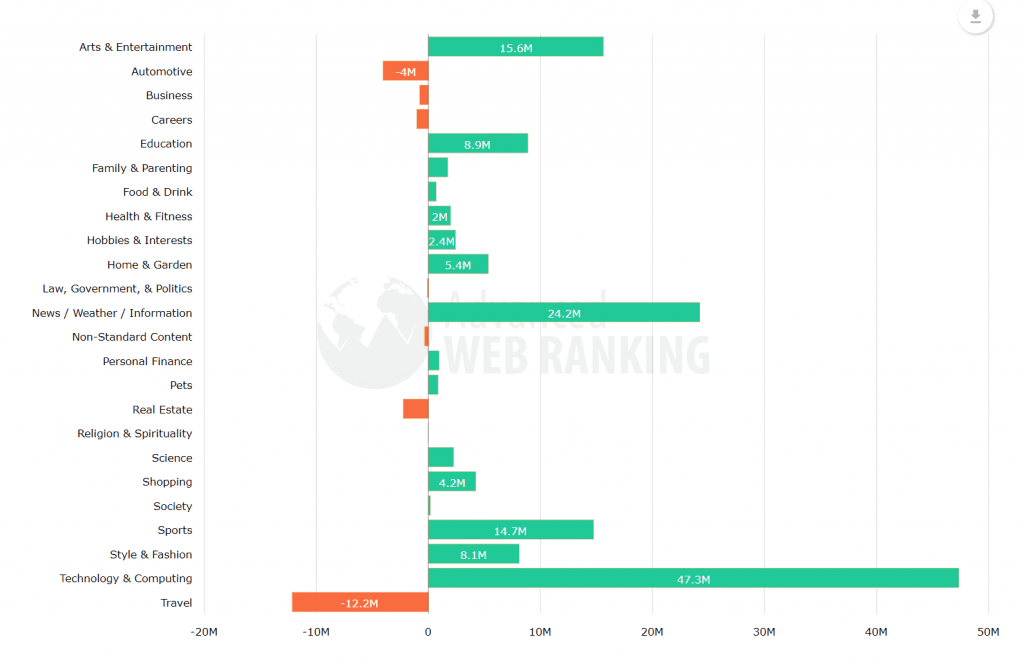
You can also dig into the subcategories to see what the performance looks like. In the example below, we’re reviewing the Travel vertical which is broken down into Air Travel, Hotels, and various destinations.
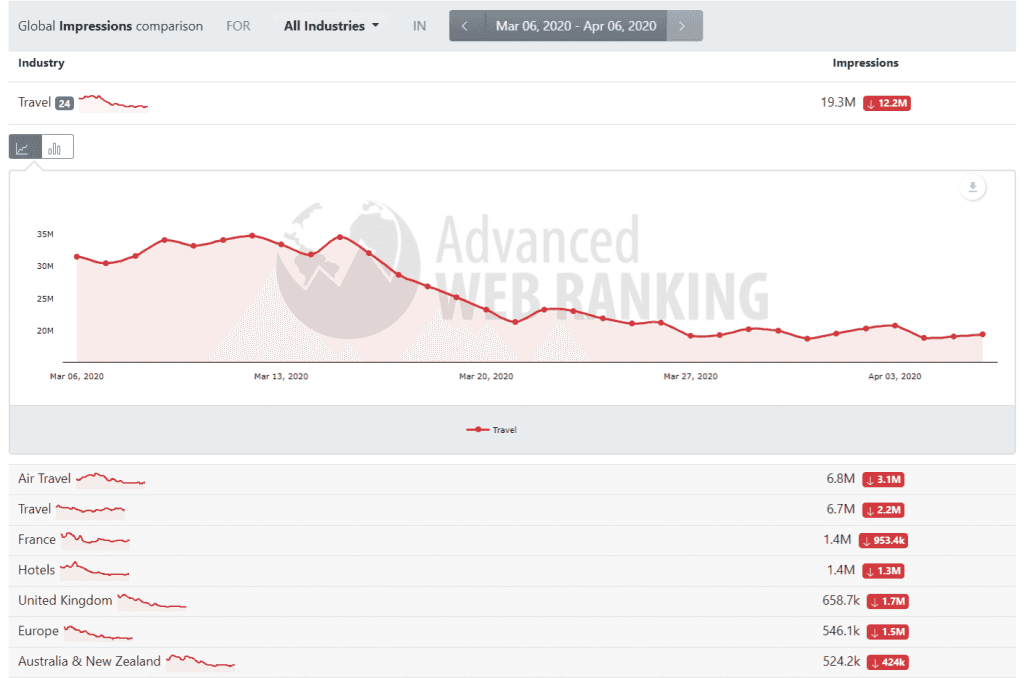
As the data is aggregated across many sites, the tool is a great resource in helping to decipher search demand trends for a given space versus algorithmic trends.
How to Approach Search Marketing During COVID-19
Now, more than ever, we must remove abstractions like user, consumer, client, and customer and be acutely aware of the person on the other side of the web browser. Here are a few principles you should consider following with your Search Marketing efforts.
Be Empathetic - Look to help your audience before thinking of selling them something. We are all going through something unprecedented and we want to feel as though the brand we’re dealing with cares and understands. Tone-deaf brands will become long term running jokes.
Reassess your market segments - Any market segmentation work your brand is working from is far less applicable now. Review those market segments and layer the implications of their behavioral changes now that they are not leaving their homes regularly and they are less likely to spend money. Harvard Business Review shared a framework for this that you can consider adopting.
Watch the trends with cities and countries that are ahead of yours - China and San Francisco are ahead of NYC on the recovery curve. You may be able to learn from your customers in those areas before recovery in other areas and extrapolate from their behavior to get ahead of supporting people through content and keyword opportunities.
Measure Relentlessly - As always, you want to measure what keywords and content are meeting people’s needs and be continually proactive with keyword research to identify how else you can help people.
At iPullRank, we’re continuing this conversation deeply and we’re hosting a Marketing in the Age of COVID-19 webinar on April 22nd. We’ll be talking in great detail about these issues and how you can continue to help the world make it through with your marketing efforts. Sign up here and keep healthy!
Article by
Mike King
An artist and a technologist, all rolled into one, Michael King is the founder of enterprise digital marketing agency, iPullRank. Mike consults with companies all over the world, including brands ranging from SAP, American Express, HSBC, SanDisk, General Mills, and FTD, to a laundry list of promising startups and small businesses.
stay in the loop





